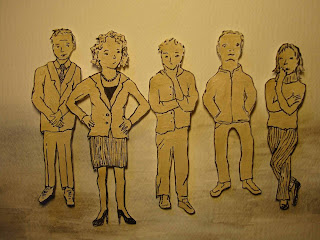 Do you watch CSI? Of course you do. It’s arguably the best TV drama on crime forensics ever made (sorry, Jack Klugman fans). The science is mind-boggling and sometimes you wonder if the technology they’re using really exists.
Do you watch CSI? Of course you do. It’s arguably the best TV drama on crime forensics ever made (sorry, Jack Klugman fans). The science is mind-boggling and sometimes you wonder if the technology they’re using really exists.Get out of the laboratory and leave the technology behind, however, and you’ll see another science at work on CSI that’s much more subtle, but just as mind boggling. It’s the science of congruency. Let me explain how it works.
Jim Brass from CSI Las Vegas takes a suspect into a small, dark room outfitted with nothing but a table and some chairs. This is his laboratory. He starts asking some simple questions and watches for the suspect’s reactions. Then the questions get tougher and Brass finally comes out and accuses the suspect of the murder or crime in question. Now he observes carefully, because without fail, this is where the suspect will deny.
When he does, Brass is paying attention to five of the suspect’s communicative signals – word choice, tone of voice, facial expression, eye contact and body posture. If all five of those signals send the same message at the same time, then Brass knows that the suspect is telling the truth. The suspect’s signals, in other words, are congruent. However, if one of those signals is even the slightest bit out of alignment, Brass can detect that. He’s professionally trained to do so. When the suspect’s signals are not congruent, Brass leans harder and asks even tougher questions until the suspect finally cracks.
 Believability in your business presentations works almost the same way. Even though your audience might not be professionally trained in congruency, they can still detect if one of your communicative signals is out of alignment with the rest. Maybe your facial expression and your words are sending different messages. Perhaps your body posture is betraying a lack of confidence. Or possibly, just at that critical moment, you broke eye contact. As insignificant as these incidents may seem, they play a big part in congruency, and therefore in getting your audience to believe you.
Believability in your business presentations works almost the same way. Even though your audience might not be professionally trained in congruency, they can still detect if one of your communicative signals is out of alignment with the rest. Maybe your facial expression and your words are sending different messages. Perhaps your body posture is betraying a lack of confidence. Or possibly, just at that critical moment, you broke eye contact. As insignificant as these incidents may seem, they play a big part in congruency, and therefore in getting your audience to believe you.To ensure that your signals are in alignment with each other, the most critical step for you is to know your material inside and out and to anticipate any questions that may arise. This will elevate your confidence levels and will immediately show up in the way you address your audience.
Speak with clarity and project your voice throughout the room. Stand up straight, elevate your chin just slightly and lift your shoulders back. Then, face your audience directly, make eye contact, and greet them with a smile on your face.
Now, that would impress Jim Brass.










